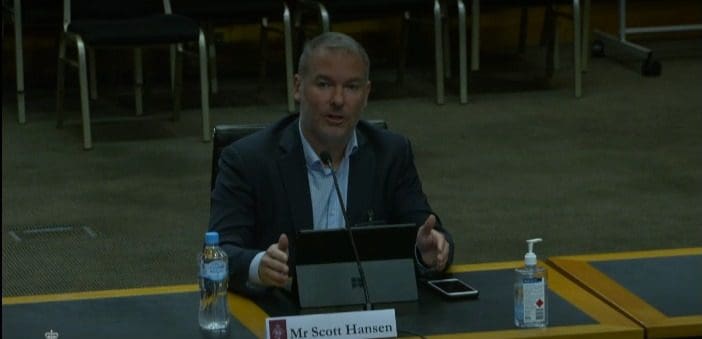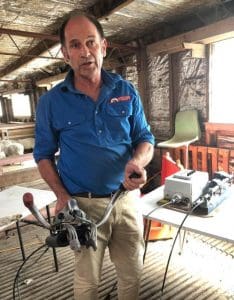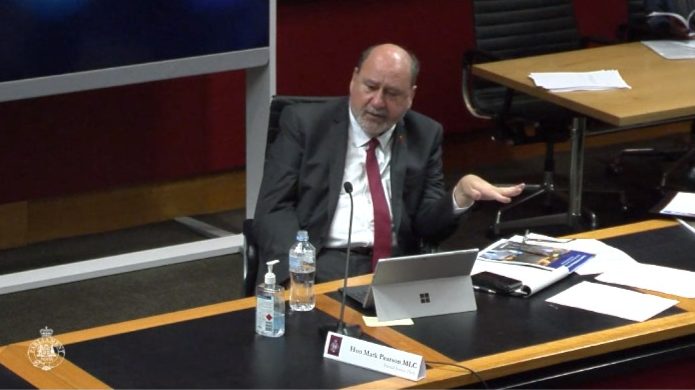
NSW DPI director general Scott Hansen – mulesing ban poses risk of substantial animal welfare concerns.
NEW South Wale’s wool industry was not ready or willing for mulesing to be banned within 18 months, a NSW parliamentary inquiry heard yesterday.
However, the hearing gave an insight into the possibility for a new mulesing end-date and the consequences of no industry action on ending the practice or not mandating pain relief.
The committee inquiring into the Prevention of Cruelty to Animals Amendment (Restrictions on Stock Animal Procedures) Bill 2019 yesterday heard from several industry bodies defending mulesing and from animal welfare organisations supporting the practice’s end and mandatory pain relief.
The Bill proposes to prohibit mulesing in NSW on and after 1 January 2022 and seeks to mandate pain relief for mulesing and other sheep surgical procedures in NSW “in order to have the benefit of a defence to certain animal cruelty offences.”
The industry and animal welfare witnesses spent hours stating the merits and consequences of mandating pain relief, with the industry lobby focused on the Bill’s implied extension of pain relief to ear tagging. However, at times, the inquiry committee appeared uninformed about key pain relief product details and no non-mulesed flock owners were listed to give evidence.
A risk of adverse animal welfare outcomes – Hansen
NSW Department of Primary Industries director general Scott Hansen declared there was a risk adverse animal welfare outcomes might arise from mandating pain relief and said the progress in NSW and nationally in moving away from the necessity to mules through genetic breeding and selection “has moved the flock forward considerably”.
“There is no way it moves from where it is today to being in a position in 2022 of not requiring mulesing or for mulesing to be prohibited within running the risk of substantive animal welfare concerns with flystrike across sheep in the state.
“I think the underlying piece here is that everyone is deeply concerned about how do we protect the animal welfare of livestock animals, the question is how do we best achieve and what combination of government intervention versus industry drive and customer preference gets us to that end-point.”
He acknowledged that producers have a legal obligation under the current POCTA Act to ensure there is no “unnecessary pain caused during the course of these procedures.”
Mr Hansen said mandating the use of anaesthetics and analgesics for certain practices “can at times lead to perverse outcomes” largely because the chemicals available are only either available by veterinary prescription or have withholding periods to ensure there are no residues in meat or milk.
Mr Hansen suggested there was a risk of a “perverse” outcome when a producer had to move sheep off a property quickly due to a rapid deterioration in seasonal conditions or fire damage.
“For them to be able to move those stock for slaughter or to move them on, they need by law to be able to ear tag them if they are cattle or sheep.
“In doing so, if they are mandated to use anaesthetics or analgesics, the most common and readily available of those (PR products) has a 90-day withholding period, which that three-month period can in certain circumstances ….. lead to a poorer animal welfare outcome than not requiring anaesthetic to be used during a process of an ear tagging or ear piercing in some of those circumstances,” he said.
Mr Hansen said this situation could also have an adverse economic impact. He didn’t mention that most producers ear tag sheep as lambs, that NSW DPI has provisions for the emergency movements of untagged stock and that only the over-the-counter topical anaesthetic product Tri-Solfen has a meat withholding period and export slaughter interval of 90 days. The anti-inflammatory products Metacam and Buccalgesic had MSI and ESI periods of 11 and 10 days respectively, but require veterinary prescription.
“The industry itself will continue to say that they strongly encourage, in fact the code and the standards and guidelines encourage the use of anaesthetics and pain relief wherever possible.
“Each and individual circumstance will dictate as to whether that is possible and how that is done,” Mr Hansen said.
“We think there is a risk in mandating, than rather than continuing with the mandating of the outcome we are looking for, which is no unnecessary pain being caused, could actually lead to perverse outcomes in some situations.”
Mr Hansen said the challenge with banning mulesing by January 2022 is can the industry have a realistic alternative tool available to it “ to move us from where we are at the moment to being in a position where there is no flystrike risk for sheep in New South Wales at that point in time.”
“And using current genetic tools available to the industry, a two-year period is just too short a timeframe to be able to get there and so you would increase your risk of flystrike, increase the poor animal welfare outcomes because of flystrike and hence why no other jurisdiction (in Australia) has moved to the point of banning mulesing.”
Mr Hansen said there is an alternative to mulesing available, but it is not available within the two-year timeframe. He said for most producers mulesing was the once-in-a-lifetime mulesing treatment option for flystrike prevention. If mulesing was prohibited from 2022, “with no alternative option other than to watch flystrike occur with no real tools available to deal with it, you would probably see a transition out of wool production into alternative farming enterprises.”
“And that would lead to a significant disruption and potentially a critical collapse in numbers across the state.”
Sheep freeze branding would not be ready in two years

Dr John Steinfort demonstrates the steining process.
Dr John Steinfort, the creator of a touted alternative to mulesing, sheep freeze branding said his company AgVet Innovations had ramped up investment and a lot of mulesing contractors wanted to switch to freeze branding. But he needed AWEX to retain freeze branding’s “non-mulesed” classification on the AWEX National Wool Declaration.
“Because it is not mulesing by definition and the way we can do that is by getting these university papers done and published and being accepted within the industry.”
When asked if he could get his “ducks in a row” and have freeze branding scaled up in time to service demand if mulesing was banned from January 2022, Mr Steinfort said: “I believe that we would not be able to ramp sufficiently to do that.”
“I believe capital-side we probably could, but this is a monitoring and a school (training) and a licensing process where we would need to train contractors and make sure they are skilled in that area.
“I believe we could not do that in the timeframe, no.”
Mr Steinfort believed there were about 110 registered mulesing contractors in Australia.
“If 75 percent of them wanted to go forward and to do this practice instead of mulesing I would say that timeframe would probably take five years if not seven years to do that.
“And we don’t want to rush that because we want this to be rolled out correctly.”
Australian Wool Growers Association director Sam Stephens said banning mulesing would jeopardise the welfare and well-being of millions of sheep. AWGA supported pain relief, but would not support banning mulesing or a phase-out deadline until a viable alternative is found.
University of Professor Peter Windsor proposed that to address international animal welfare concerns, until sheep with the genetics to significantly decrease the susceptibility to flystrike are more widely dispersed, provision of pain relief during mulesing should allow breech modification to continue where required. He supported mandatory pain relief for mulesing.
Executive director of the Australian Council of Wool Exporters and Processors, and the Private Treaty Merchants of Australia, Dr Peter Morgan said his members are opposed to any banning of mulesing because of the enormous flystrike risk.
No mulesing ban unless there is a viable alternative – NSW Farmers

NSW Farmers president James Jackson
NSW Farmers president James Jackson, Sheep Producers Australia chief executive officer Stephen Crisp and WoolProducers Australia CEO Jo Hall said their body’s opposed banning mulesing.
Mr Jackson said the application of the bill would have a negative impact on all livestock producers and would be impractical to apply. He said mandating pain relief for ear tagging and requiring the use of a product with a 90-day withholding period would put export markets at risk.
Mr Jackson conceded that breeding plain-bodied sheep helped with body and breech flystrike, but disputed that there was a point in breeding sheep when there was no further benefit of mulesing. When asked by Animal Justice Party MLC Mark Pearson if Australia should be mulesing sheep for the next 100 years, Mr Jackson said “unless there is a viable alternative we should not put a date on it.”
NSW Farmers did not support regulating pain relief uniformly, but only through an industry-led initiative. Mr Jackson said close to 85pc of the state’s wool growers use pain relief when mulesing and rapid growth in PR use for other practices if proof government intervention is not required.
“This Bill is dangerous for agriculture and our animal production industries as its application is far-reaching and broad.
“Mulesing must not be banned, doing so would expose millions of sheep to the risk of flystrike,” he said.
“Wool is produced across a range of regions and climates in NSW which require different production systems.
“These variations mean no one uniform management tool suits all wool growers, especially in regards to flystrike mitigation.”
He said the Bill’s timeframe to phase out mulesing is totally unfeasible and implausible.
“Quite simply, genetic changes cannot be achieved in 18 months.”
Mr Crisp and Ms Hall said their bodies would not support the banning of mulesing or a phase-out deadline until a viable alternative becomes available. The defended mulesing as an effective one-in-a-life procedure that offers lifetime protection against breech flystrike.
Ms Hall said WPA opposed the current wording of the Bill and said unfortunately the debate around mulesing had become binary “where those who think they are acting in the best interests of sheep believe that mulesing equals bad animal welfare, while not mulesing equates to good animal welfare outcomes.
“It is simply not that black and white.”
Sheep Central will outline the outline the arguments of the animal welfare groups put to the inquiry in article later this week.
Where to from here….

Animal Justice MLC Mark Pearson at the inquiry hearing.
But after the hearing, in an indication of where negotiations around the Bill might go, Mr Pearson raised the prospect of pain relief for ear tagging being excluded from the Bill and the mulesing ban deadline being extended.
He said it was bizarre that so much focus was put on ear tagging “which is probably the least painful and least distressing thing.”
“The main thrust of the bill is the ban on mulesing and pain relief applied for the most invasive mutilations of the animal.
“So if there was to be an amendment to say that this will not include ear tagging, I think we could live with that.”
Mr Pearson said although he initiated the Bill, amendments could be suggested by anyone in the house. There would now be a deliberation by the inquiry committee, a report, he would probably give a dissenting report and it will be up to Mr Pearson to bring the Bill back to the house for finality.
“In the meantime, if I flagged that I would be bringing it back, depending on what happens between now and then in terms of activism, somebody might move an amendment on ear tagging and the phase-in period to be five years.
“If the house votes that way, that’s it,” Mr Pearson said.
“I could live with five years, if it is a deadline, probably in 1.5, two or three years most lambs will not be mulesed, because that will be part of the whole process of moving across,” he said.
“So I could live with that and I wouldn’t oppose the removal of ear tagging from the requirement for analgesia.”
Mr Pearson also highlighted the implications of the Bill not passing, and of section 24 in the current POCTA Act in NSW that allows for the mulesing of lambs, but without causing “unnecessary pain.”
Mr Pearson said Professor Windsor and RSPCA NSW chief veterinarian Dr Elizabeth Arnott agreed with him that producers who chose to mules sheep without pain relief would be causing harm to an animal with unnecessary pain.
“The prosecution would argue the person has mulesed and has caused unnecessary pain, because they could have spent a dollar on pain relief and they haven’t.
“They wouldn’t be protected by the POCTA Act, because of that very part,” he said.
“So what I am flagging there is if we don’t get mandatory pain relief then Adam Marshall, the NSW Minister for Agriculture, is putting all those wool growers in a very dangerous predicament.”
Professor Windsor agreed to a suggestion from Mr Pearson that if mulesing or another mutilation of an animal occurred without pain relief could it be argued that the procedure caused pain that was not necessary.
“I would agree with that statement.
“You cannot deliver an intervention in a normal husbandry environment without some pain, but certainly you can diminish the pain significantly with the current available pain relief mechanisms.”
Dr Arnott said she agreed with Mr Pearson’s assessment that “in today’s circumstances with accessibility and ease (in obtaining pain relief) it is a reasonable interpretation” that the pain caused by not using pain relief when mulesing “is unnecessary and unjustifiable.”
“I have a regulatory background and I’m not part of the enforcement aspect, but I would say that the legislative intention of the section (24) isn’t clear and I think for industry and enforcement agencies that ambiguity requires removal if there is a hope of prosecuting, and if that’s what the intention is.”

Mandatory pain relief for ear tagging is mentioned, but tail docking and castration doesn’t appear to be mentioned anywhere in here?
Do humans require mandatory pain relief when they get their ears pierced?
Most producers and vets I talk to agree that castration and tail docking without pain relief is as uncomfortable for the lamb as mulesing – yet it seems bizzare that this has focused on-ear tagging?
Will tail docking and castration (without pain relief) remain the skeleton in the farmyard closet?
Robin Smith – the inventor of Numnuts.
Editor’s note: Robin, industry speakers at the hearing focused on ear tagging as a major issue in mandating pain relief, despite limited concern by animal welfare witnesses about ear tagging as a painful procedure.
Robin Smith, another clear thinker, brilliant, go to the head of the class.
This inquiry into animal welfare did little to advance the issues involving the mulesing of sheep. It appears that there is a determination to maintain the present situation. As such sheep will still need to be mulesed and treated for body strike with chemicals.
I was somewhat surprised to hear speakers saying that nothing could be done until an alternative is found.
For the interest of those involved, an alternative has been developed, it is called the genetic solution.
Many Merino studs have been breeding sheep that don’t not need to be mulesed and have ceased mulesing as early as 2005.
Commercial producers that have followed a breeding plan to go mules-free have been able to achieve this in two sheep generations.
In addition, other benefits have included very little to no body strike, higher fertility and lamb survival, no need for fly preventative chemical and lower sheep maintenance requirements.
Thus, in fixing the current issue under discussion, improvements in other areas of welfare are dealt with as well.
So, direction from here, I would suggest a five to seven year window to have the state mules-free and in the interim the mandating of pain relief as people make the change.
The work has been done, people are producing mules-free, fly-resistant sheep, simply by using the genetic solution.
Unforeseen consequences is what it gets down too. Becoming Clik junkies and chemical residues. Shearers turn up on time every year do they? Is that going to happen this year? Northern WA wheatbelt contractor I know normally has 140-odd people working through the Spring. This year he got about 26 locked in. That wet year over east 2016 was it, every fly treatment ran out over east and the WA stockists were taking it off WA shelves. All those WA sheep that went east to the big wet had a lot of strike issues and the chemicals did not stand up to the heavy rains. By all means, if you don’t want to mules, all power to you. Congralutions, but you are not running other people’s lives or farms, or is that what you really want to do? No doubt, there are zones a lot colder with higher altitudes, worse frosts and greater wind speed than where I come from, but that’s rather the point is it not? Judging by the results that came out of the Mount Barker Research Station trials, in a wet year the responsible thing was mulesing.
Glenn Nix, I agree completely with you with what is happening and what did happen. The last thing anyone wants to do is tell someone how to run their farm.
However, can you please tell me why sheep producers don’t want to breed sheep that don’t need to be mulesed and don’t get flyblown? What is stopping people going down this path?
The problem may be that sheep producers don’t believe that breeding programs can produce fly-proof sheep.
All I can suggest to those people is to ask questions, visit those that are doing it and then make up your own mind.
This article has many sheep industry leaders defending mulesing for a number of reasons. Can any of these leaders explain how they would defend the mulesing of close to 70 percent of all first cross ewes sold at multi-vendor sale throughout Australia?
How are we going to move forward when we mules first cross maternal ewes?
There are a couple of things at play here. One is that they have always mulesed this type of ewe, so why change. The other is that a lot of crossbred ewes are bred from the wrinkliest Merino ewes and the first cross is carrying a heap of wrinkle still. The problem can be solved with a genetic change in the Merino. To do that requires a thinking change by the person in charge. The genetic change is easy, the mindset changes appear to be much more difficult.